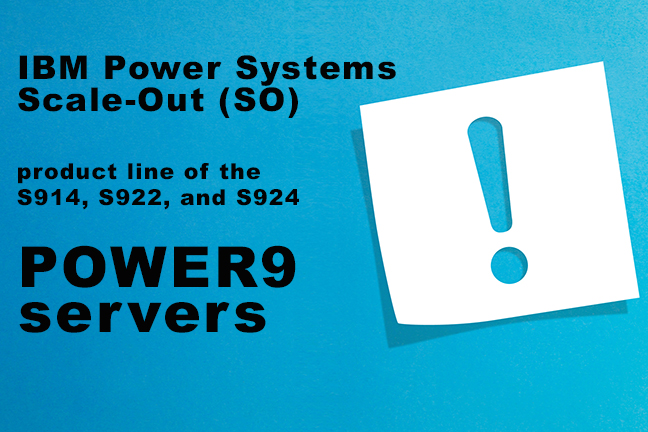Ron Gordon
Director » Power Systems
On July 14, IBM announced significant enhancements to the IBM Power Systems Scale-Out (SO) product line of the S914, S922, and S924 POWER9 servers. The new upgraded Power9 systems will begin shipping July 24, 2020. The servers will have the same model numbers but will now end with a “G.” The LC, AC, IC, and L models remain unchanged at this time.
New Configuration Changes: Even More Power from Power9
So, what are the changes, you ask. There are several.
- The full IBM Power System Scale-Out product line has upgraded the internal switches from PCIe Gen3 to PCIe Gen4, providing improved throughput for all PCIe adapters and storage bays. This change will allow all PCIe slots to now support PCIe Gen4 adapters.
- The storage bays can now support up to four NVMe U2 media. This could represent up to a 10% gain in performance, depending on I/O activity. The new U2 NMVe drives come in 1, 3, and 6 TBs.
- The new IBM Power Systems SO922 will increase the number of PCIe slots from six to eight, providing more adapter support and more ports for I/O operations.
- The SO922 also now offers the 11-core IBM POWER9 processor, enabling up to 22 cores, whereas the previous maximum was 20.
- There is now a single-core SO922 model that is exclusively for IBM i with no support for Linux or AIX and has a P05 rating. This is still a 2U rack mount system and it is not available in a tower format which the SO914 offers.
While these changes are significant, several aspects of the IBM Power Systems Scale-Out family have not changed. While the Gen4 switch change does affect the I/O bandwidth capabilities, the memory bandwidth does not change from the 410 GB/s as it does in the “A” models. PowerVM Enterprise continues to be included at no charge, except SWMA is required.
Enterprise Pools 2.0 with Dynamic Capacity on the New Power9 “G” Models
While all of these changes are significant and offer improvements in technology to support high performance and big data capacity—all without a cost increase, by the way—the addition of support for Enterprise Pools 2.0 with dynamic capacity may be the most significant.
IBM Enterprise Pools 2.0 with dynamic capacity allows customers to only pay for baseline system capacity usage (cores and memory) that they set on a fully configured system. If a workload temporarily needs extra resources, the capacity need is satisfied automatically and paid for on a per-minute basis. The capacity is based on the total capacity of the system defined to a “pool” and, as long as the total capacity is not exceeded, there is no extra charge. (For more details, please refer to my blog IBM Announces Power Systems Private Cloud Solution with Dynamic Capacity.)
Previously, this capability was limited to IBM Power Systems E950s and E980s. Starting in August, however, you will be able to create an EP2.0 on the new “G” models of SO922s and SO924s in the same pool. Memory is not supported in the Scale-Out EP2.0, but base cores can be as low as one core and memory must be at least 256GB on the systems participating in the pool. Cloud Management Console continues to be required and a single CMC can manage 950, 980, and SO pools.
The addition of EP2.0 with dynamic capacity creates an interesting hybrid cloud experience where both on-premise systems with “cloud-like” variable capacity can provide systems consistency by interacting with the Power System 922s in the IBM Cloud via IBM Cloud Paks Multi Cloud Manager. This provides easier performance modeling and software planning and could be a key reason to consider upgrading from the IBM Power Systems Scale-Out POWER8-based systems. The Dynamic Capacity capability will be available August 28, 2020.
More Information
To review more announcement details and learn more about how IBM Power Systems may be beneficial to you, please contact your Mainline Account Executive directly or click here to contact us with any questions..
You may be interested in:
Blog: IBM Announces Power Systems Private Cloud Solution with Dynamic Capacity

